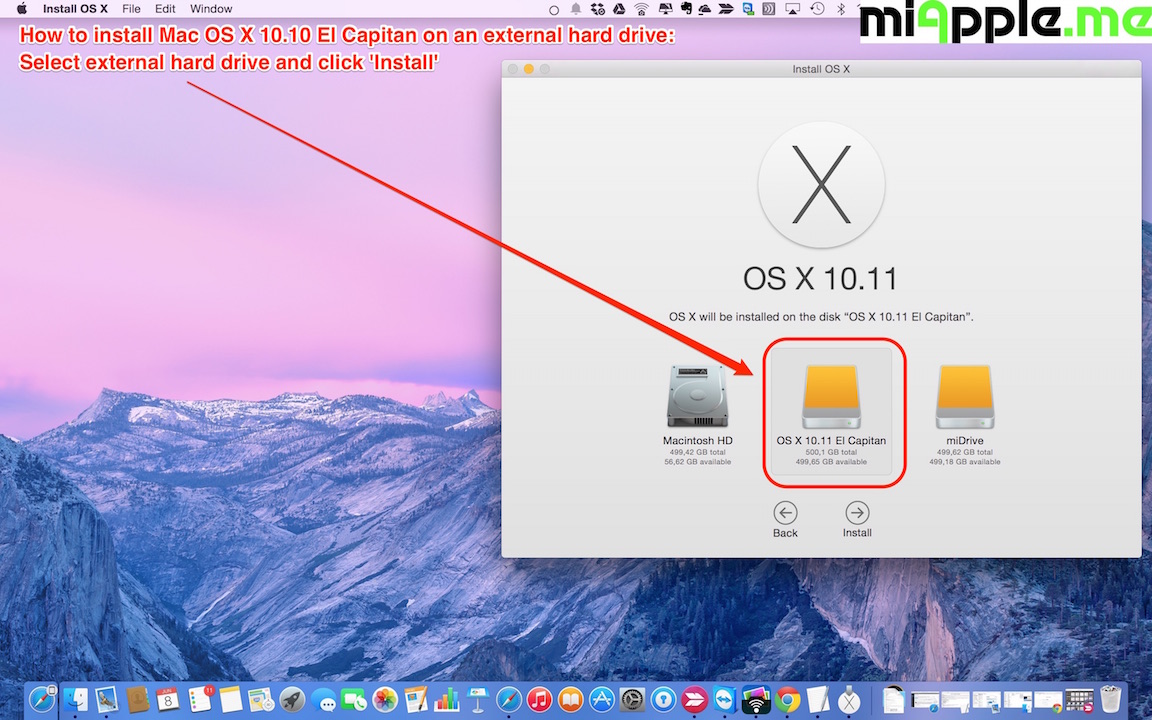
(but there are plenty of other ways to do this) Right-click -> "Open With Other Application." -> "Disk Image Mounter"

Then mount the image: In Linux Mint, I used So, I needed to first convert this file into an image:ĭmg2img InstallMacOSX.dmg InstallMacOSX.img However, this contains a file called "InstallMacOSX.dmg", rather than "InstallESD.dmg". Instead, I downloaded the "El Capitan" installer. I tried to use the internet installer that came with it, but it would not work without signing into the original owner's AppleID (even though I specifically went into iTunes to "De-Authorize this computer" before wiping the original installation)
#Usb mac os x el capitan install
I already extracted from the installer the file InstallESD and is sitting in the working directoryĤ0 mount /dev/mapper/loop14p2 /mnt/OSX_InstallESDĤ1 dmg2img /mnt/OSX_InstallESD/BaseSystem.dmg BaseSystem.imgĤ3 mount /dev/mapper/loop15p1 /mnt/OSX_BaseSystemĤ8 man partprobe #got a message that the partition was not going to be visible untill I use partprobe or rebootĥ0 sgdisk -n 1:0:0 -t 1:AF00 -c 1:"disk image" -A 1:set:2 /dev/sdbĥ5 mkfs.hfsplus -v "OS X Base System" /dev/sdb1Ħ0 rsync -aAEHW /mnt/OSX_BaseSystem/ /mnt/usbstick/Ħ1 rm -f /mnt/usbstick/System/Installation/PackagesĦ2 rsync -aAEHW /mnt/OSX_InstallESD/Packages /mnt/usbstick/System/Installation/Ħ3 rsync -aAEHW /mnt/OSX_InstallESD/BaseSystem.chunklist /mnt/usbstick/Ħ4 rsync -aAEHW /mnt/OSX_InstallESD/BaseSystem.dmg /mnt/usbstick/Īfter hours of trial and error, I was finally able to install OSX 10.11 "El Capitan" on my used iMac (mid 2009)! Thanks all of the above for pointing into the right direction! Under i just paste my terminal history that gave me a working usb drive. The "loop0p2" and the loop1p1 and the dev/sdX according to your usb mount.Īt some point you need to umount the usbdrive if "mount point busy" message. The only need you need to change on the lines are. On my machines there was already 12 loopsĮvery now and then use "df" just to see which partitions and names you have in your system. Kpartx you need to add -v (verbose) to see which loop is created so :kpartx -av InstallESD.img Run all the commands it as root! so use "sudo su" Only things that need to take into account are: Rsync -aAEHW /mnt/OSX_InstallESD/BaseSystem.dmg /mnt/usbstick/ Rsync -aAEHW /mnt/OSX_InstallESD/BaseSystem.chunklist /mnt/usbstick/ Rsync -aAEHW /mnt/OSX_InstallESD/Packages /mnt/usbstick/System/Installation/ Rsync -aAEHW /mnt/OSX_BaseSystem/ /mnt/usbstick/ Mkfs.hfsplus -v "OS X Base System" /dev/sdX1 # partition the USB flash drive, /dev/sdX Mount /dev/mapper/loop1p1 /mnt/OSX_BaseSystem # convert base system disk image to raw formatĭmg2img /mnt/OSX_InstallESD/BaseSystem.dmg BaseSystem.img Mount /dev/mapper/loop0p2 /mnt/OSX_InstallESD app/Contents/SharedSupport/InstallESD.dmg" InstallESD.img # convert installer disk image to raw formatĭmg2img "Install OS X. Mkdir -p /mnt/OSX_InstallESD /mnt/OSX_BaseSystem /mnt/usbstick There is no need to try using the script, as it works with the list of commands on the read me file. This works! I used it for making a usb from El Capitan installer, using the InstallESD.dmg that you find inside the InsallMacOSX.dmg. rsync supports also -X parameter, supposed to copy HFS+ extended attributes, but in practice it fails with the error "Operation not supported". It is possible to copy with other tools (tar, cpio), just supply parameters preserving the most of file metadata. Rsync -aAEHW -P /mnt/installesd/BaseSystem.chunklist /mnt/usbstick/ Rsync -aAEHW -P /mnt/installesd/BaseSystem.dmg /mnt/usbstick/ Rsync -aAEHW -P /mnt/installesd/Packages /mnt/usbstick/System/Installation/ Rm -f /mnt/usbstick/System/Installation/Packages Mkfs.hfsplus -v "OS X Base System" /dev/sdb1Ĭopy missing installer files (beware of ending /): rsync -aAEHW -info=progress2 /mnt/basesystem/ /mnt/usbstick/ Mount /dev/mapper/loop1p1 /mnt/basesystemįormat the USB flash drive as HFS+: sgdisk -o /dev/sdb
#Usb mac os x el capitan free
But writing it directly to the USB drive does not work, because that would create a partition with almost no free space and still lacking some important files.Įxtract base system image BaseSystem.dmg, convert into raw and mount too: dmg2img /mnt/installesd/BaseSystem.dmg BaseSystem.img InstallESD.dmg contains another disk image, BaseSystem.dmg, which is a bootable installer disk. Mount /dev/mapper/loop0p2 /mnt/installesd Working as a root, convert InstallESD.dmg into raw image format and mount it using kpartx: dmg2img InstallESD.dmg InstallESD.img InstallESD.dmg is an image of a GPT disk with HFS+ partition which contains installer files, but is not bootable itself.

Manually it's as mentioned in MacWorld, but using the Linux tools:

There's a ready script that automates this whole process.


 0 kommentar(er)
0 kommentar(er)
